APRIL (NOT JUNE)
IS BUSTING OUT ALL OVER
Although a careful observer knows nature doesn't quit functioning when weather turns cold, sometimes it's hard to find evidence that the woods are still alive at mid-winter. From November through February, deciduous trees are without foliage, many of our colorful songbirds are far to the south, and small mammals are either hibernating or carrying out a slower-paced existence beneath a thick layer of leaf litter. Come spring, however, nature starts anew in the Carolina Piedmont, and most years by the first week in April things are unfolding so fast it's almost impossible to keep up with day-to-day changes. That was certainly the case this week, so rather than trying to decipher the details of all that transpired we'll just provide a few photos to prove that at Hilton Pond Center it's April--not June--when things are "busting out all over."
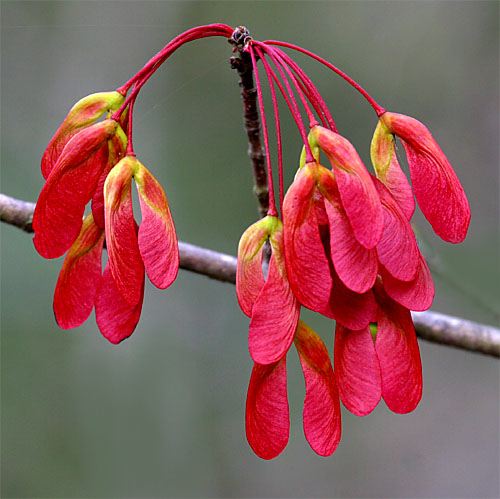
All text & photos © Hilton Pond Center
Being one of the first plants to flower on the banks of Hilton Pond, our Red Maples finish blooming by mid-March, and they're already setting seed by the first of April (above). Paired winged fruits of the maple--called "samaras"--are so colorful that at a distance they seem to be the tree's blossoms. Within the next week or so each seed pair will break away from the stalk that holds it to the twig, and single seeds will helicopter to a spot some distance from the parent tree. We've yet to figure why a wind-dispersed samara should turn brilliant red when ripe--a strategy usually reserved for brightly hued berries that need the dispersal services of some animal with discerning color vision.
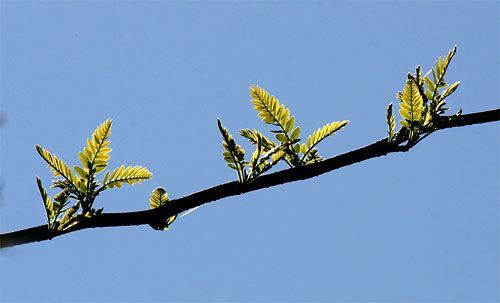
On a small meadow near Hilton Pond itself is another interesting spring sight. Looking like so many ferns on a stick, the compound leaves of a Honeylocust tree unfurl along their branch, glowing green against the blue spring sky. Even leaves from buds on the limb's bottom surface curl upward,providing testimony to the importance of growing toward the light and maximizing photosynthesis--especially in spring when the tree's stored resources are all but depleted. We noted that leaves from buds on top of each Honeylocust branch open first and are further along, perhaps because those on the bottom are a little more shaded from the stimulating warmth of the sun.
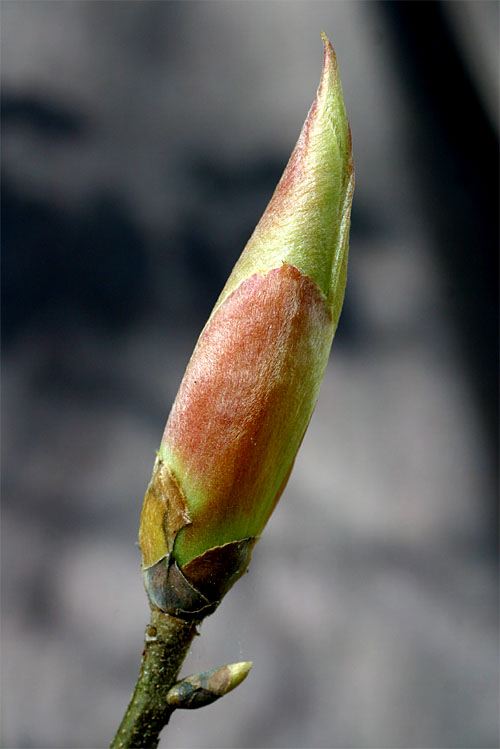
We've always been appreciative of various attributes of the towering Shagbark Hickory that grows just outside our office window at Hilton Pond Center. We take great delight from observing the texture of exfoliating bark that gives the species its name; we like its big, broad compound leaves that cast cooling shade on our workspace all summer long; and we consider the hickory's sizeable husk-covered nuts to be very impressive ways to reproduce--or, more likely, to feed the local wildlife. We especially enjoy the hickory tree in spring, when its fat half-inch terminal buds begin to swell, eventually elongating into an aesthetically pleasing spindle at least four times that length (above).
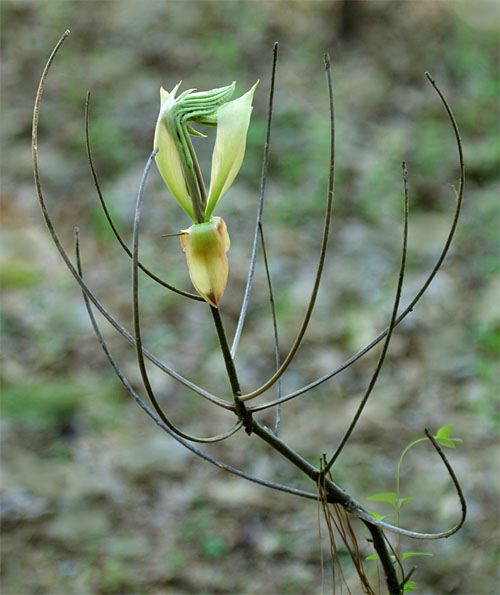
Hidden inside the terminal bud are fast-developing leaves and leaflets that soon will provide that foliage umbrella we'll cherish in the heat of July and August. We've observed that Shagbark Hickory saplings--daughter trees, no doubt, of the stately matron outside our office--have especially large terminal buds, and that young trees often retain long, narrow petioles from last year's leaves. These now-naked leaf stems curl upward like wires (above)--almost as if to protect the fresh terminal growth they surround--and stand in stark contrast to the sensuousness of the rapidly unfolding bud.
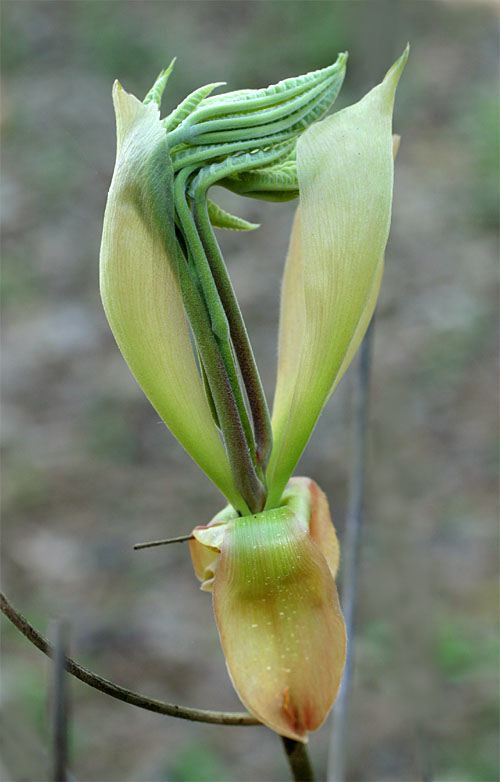
When spring temperatures rise and day length increases, the dormant winter bud practically explodes, leaving its dry scales at the base of new growth. These winter bud scales--essentially dead matter that protects the living tissue beneath--are forced open by new scales that are alive and very fast-growing. The new bud scales (above)--two outer ones with reddish edges and two inner ones that are very pale green--fold back at the base, eventually exposing the hickory leaflets hidden inside.
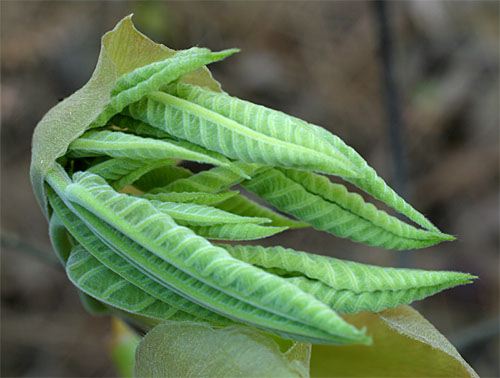
As the new bud scales separate (above), they reveal an intricate springtime structure that pleases the eye, the mind, and the soul. Edges of the five leaflets on the compound leaf curl toward each leaflet's center, and the central and side veins of the leaflet are already formed--standing by to transport water and nutrients to the leaf blades and, in return, send the products of photosynthesis back to the rest of the tree. To our way of thinking, what this photo depicts is every bit as delightful--and miraculous--as the birth of any of the millions of living species on Earth, humans included.
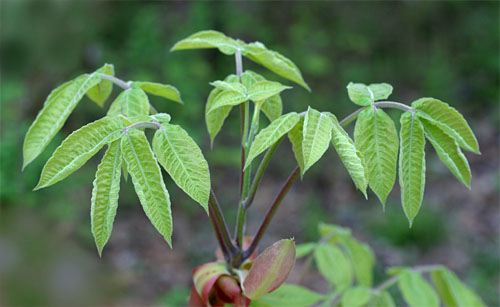
And that's really what spring in the Carolina Piedmont (and elsewhere) is all about: The birth and rebirth of plants and animals and other living things that have lain dormant all winter, just waiting for a chance to go about the business of production--and reproduction. Red Maples make thousands and thouands of red samaras, Honeylocust trees re-foliate their branches, and from a scraggly half-inch terminal bud the Shagbark Hickory somehow produces six new leaves and 30 pale green leaflets that give new life to the hickory tree itself. All this and more make spring a very special time and goes to prove our point that--here at Hilton Pond Center--it's April (not June) that is "busting out all over."
All text & photos © Hilton Pond Center
Comments or questions about this week's installment?
Please send an E-mail message to INFO.
NOTE: Be sure to scroll down for an account of all birds banded or recaptured during the week, as well as some other interesting nature notes.
"This Week at Hilton Pond" is written & photographed
by Bill Hilton Jr., executive director of
Hilton Pond Center for Piedmont Natural History.
You may wish to consult our Index of all nature topics covered since February 2000. You can also use the on-line Search Engine at the bottom of this page.
For a free, non-fattening, on-line subscription to "This Week at Hilton Pond," just send us an E-mail with SUBSCRIBE in the Subject line. Please be sure to configure your spam filter to accept E-mails from hiltonpond.org.
|











